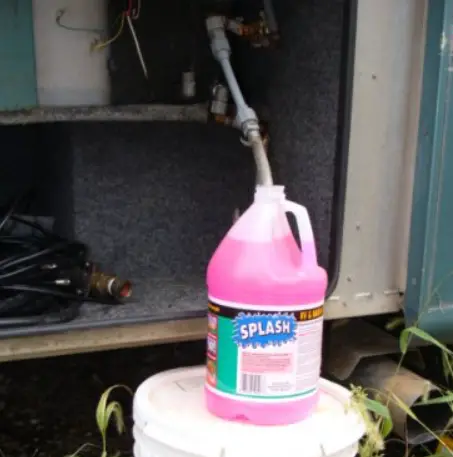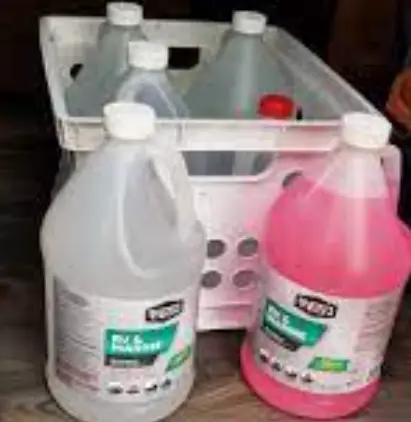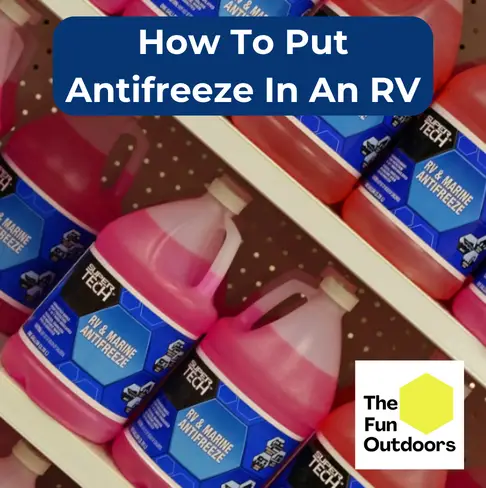RVs are a great way to travel and explore the outdoors, but when winter comes around, RV owners need to take extra precautions to protect their vehicles. One essential step in winterizing an RV is knowing how to put antifreeze in your RV or camper.
Putting antifreeze in an RV involves draining all the water from your RV, bypassing the water heater, connecting to the antifreeze inlet, and pumping the antifreeze in to the RV system. We’ll go through everything step-by-step in detail in this guide.
[TABLE OF CONTENTS]
Step-by-Step Guide to Adding Antifreeze to Your RV

One of the most important steps of the RV winterization process is adding antifreeze to the plumbing system. Here is a step-by-step guide to help you through the process.
Gather Your Supplies
Before you begin, make sure you have all the necessary supplies. You will need at least 2-3 gallons of RV antifreeze, a water pump converter kit, a bucket, and a funnel.
Locate the RV’s Antifreeze Inlet
The antifreeze inlet is typically located near the water pump. Consult your RV owner’s manual to locate it.
Drain the Water System
To start, drain the water system completely. Turn off the water heater and open all faucets and drains, including the city water inlet and low point drains. Allow all water to drain out completely.
Empty All Water Lines
Once the water system is drained, empty all water lines. This can be done by blowing compressed air through the lines or by using a hand pump.
Bypass the Water Heater
Bypass the water heater by turning the bypass valve to the “bypass” position. This will prevent antifreeze from entering the water heater.
Connect the Antifreeze
Connect the water pump converter kit to the antifreeze inlet. Place the other end of the kit into a bucket filled with antifreeze. Turn on the water pump.
Pump the Antifreeze
Finally, pump the antifreeze using an RV antifreeze pump through the entire plumbing system. Turn on each faucet and run the water until you see the antifreeze coming out. Repeat this process for the toilet, shower, and any other water outlets.
By following these steps, you can be sure that your RV’s plumbing system is properly winterized and protected from freezing temperatures.
Common Mistakes to Avoid

When it comes to putting antifreeze in an RV, there are a few common mistakes that people often make. These mistakes can lead to damage to the RV’s plumbing system or even health problems for those using the RV.
In this section, we will outline some of the most common mistakes to avoid when putting antifreeze in an RV.
First, it is important to use the correct type of antifreeze. Automotive antifreeze is highly toxic and should never be used in an RV’s plumbing system. Instead, use propylene glycol-based RV/marine antifreeze, which is safe to use in the fresh water plumbing system and does not leave a lingering aftertaste.
Another mistake to avoid is not using enough antifreeze. The recommended amount of RV antifreeze for an RV depends on the size of the RV. It is important to use enough antifreeze to fully protect the plumbing system from freezing temperatures. Most RVs will use roughly 2-4 gallons of RV antifreeze.
One common mistake is forgetting to bypass the water heater before putting antifreeze in the RV. If the water heater is not bypassed, it will require a lot more antifreeze to fully protect the system. This can be a costly mistake, as it will require more antifreeze and take longer to winterize the RV.
Finally, it is important to properly dispose of any leftover antifreeze. Antifreeze is toxic and should not be poured down the drain or onto the ground. Instead, dispose of it at a designated hazardous waste disposal site.
See Related: Is RV antifreeze safe for septic systems?
By avoiding these common mistakes, you can ensure that your RV’s plumbing system is properly protected during the winter months.
Choosing the Right Antifreeze for Your RV
When it comes to choosing the right antifreeze for your RV, there are a few things to consider. The first thing to keep in mind is that not all antifreeze is created equal. There are different types of antifreeze, each with its own unique properties and uses.
The most common type of antifreeze used in RVs is propylene glycol-based antifreeze. This type of antifreeze is non-toxic and safe for use in drinking water systems. It is also biodegradable and environmentally friendly. Propylene glycol-based antifreeze is typically pink in color, which makes it easy to distinguish from other types of antifreeze.
Another type of antifreeze that is sometimes used in RVs is ethylene glycol-based antifreeze. This type of antifreeze is toxic and should never be used in drinking water systems. It is also not biodegradable and can be harmful to the environment. Ethylene glycol-based antifreeze is typically green in color.
When choosing the right antifreeze for your RV, it is important to read the label carefully and make sure that it is safe for use in your specific RV. Some antifreeze is designed for use in automotive cooling systems and may not be safe for use in RVs.
It is also important to consider the temperature rating of the antifreeze. RV antifreeze is typically rated for use at temperatures as low as -50 degrees Fahrenheit. If you plan on storing your RV in an area with extremely cold temperatures, you may want to consider using a higher-rated antifreeze.
Safety Precautions
When handling RV antifreeze, it is important to take the necessary safety precautions to prevent any harm or accidents. Here are some safety tips to keep in mind:
- Wear protective gear: Always wear gloves and safety glasses when handling RV antifreeze. This will protect your skin and eyes from any potential harm.
- Keep antifreeze away from children and pets: RV antifreeze is toxic and can be harmful if ingested by humans or animals. Keep it stored in a safe place out of reach of children and pets.
- Use the right type of antifreeze: Make sure to use RV antifreeze specifically designed for RVs. Automotive antifreeze (ethylene glycol) is not safe for RV plumbing systems and can cause damage.
- Turn off all appliances: Before beginning the antifreeze process, turn off all appliances that use water, such as the water heater and pump. This will prevent the antifreeze from entering these appliances and potentially causing damage.
- Follow manufacturer instructions: Always follow the manufacturer’s instructions when using RV antifreeze. This will ensure that you are using the correct amount and that the process is done safely and effectively.
Check out our other helpful related RV guides while you’re here:

